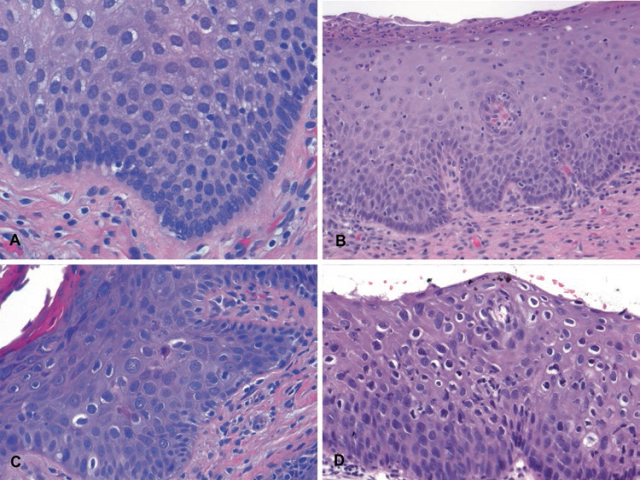我的博文
《病理诊断入门指南》:复层上皮的解读(二)
《病理诊断入门指南》:复层上皮的解读(一)
【细胞核的改变】
(1)细胞核(图4):反应性细胞核(Reactive nuclei)可以变大,但仍保持光滑,呈圆形卵圆形,染色质浓缩成几个小核仁或斑点(their chromatin condenses into several small nucleoli or speckles),像鸟蛋。染色质整体呈灰蓝色(The chromatin may have an overall grey-blue look),核膜常不清晰(nuclear membrane is often indistinct)。然而,非典型增生或未成熟的细胞核(Dysplastic or immature nuclei)似乎有过多的染色质(appear to have too much chromatin)。细胞核体积变大,核膜不规则成角(angulated with irregular nuclear membranes)(如巨石样),染色质均匀致密呈黑色(the chromatin is uniformly dense and dark),就像用木炭画的一样(like it was drawn with charcoal)。核膜也可能显得更厚和更明显(Nuclear membranes may also appear thicker and more prominent)。
(2)核仁(Nucleoli):明显的核仁实际上是一个更提示为反应性变化的特征,而不是非典型增生(Prominent nucleoli are actually a feature more suggestive of reactive changes than of dysplasia)。一个明显的核仁在一个光滑的圆形细胞核中,背景是细腻淡染的染色质,很可能是良性的(A prominent nucleolus in a background of fine pale chromatin, in a smoothly rounded nucleus, is likely benign)。鳞癌通常在发展为侵袭性之前不会获得大而暗的核仁(Squamous carcinomas usually do not acquire large dark nucleoli until they become invasive)。
(3)细胞核与细胞质(N/C)的比率(Nuclear to cytoplasmic (N/C) ratios):N/C比率通常在基底层很高(主要是指细胞核和最小的细胞质/meaning mostly nucleus and minimal cytoplasm),但随着细胞成熟并移向表面,N/C比率应该会下降(but should fall off as the cells mature and move to the surface)。表面高N/C比(A high N/C ratio at the surface),特别是在“巨石”核的背景下(especially in the setting of “boulder” nuclei),是非常令人担忧的(is very worrisome)。这就给人一种在低倍镜下呈蓝色印象(This creates the impression of blueness at low power)。

图4 反应性,良性细胞核(A, B)和非典型增生的细胞核(C, D)的例子:在反应性条件下,细胞核可能增大,核仁可见,但N/C比值仍然较低(细胞质丰富),相对于表面有核极性,染色质不太暗,核膜光滑呈卵圆形。当细胞接近表面时成熟是可见的,细胞核变小,细胞质更丰富。在非典型增生中,细胞核明显较暗,N/C比值较高,上皮细胞较紊乱,细胞核(更紧密地堆积)可能呈现不规则形状以更紧密地结合在一起,类似于岩壁中的巨石。
Figure 4. Examples of reactive, benign nuclei (A, B) and dysplastic nuclei (C, D). In reactive conditions, the nuclei may be enlarged and have visible nucleoli, but the N/C ratios are still low (abundant cytoplasm), there is nuclear polarity relative to the surface, the chromatin is not too dark, and the nuclear membranes are smooth and oval. Maturation is visible in that as cells get closer to the surface, the nuclei get smaller and the cytoplasm more abundant. In dysplasia (lower panels), the nuclei are significantly darker, the N/C ratios are higher, there is more disorder to the epithelium, and the nuclei (being more closely packed) may take on irregular shapes to fit more closely together, similar to boulders in a rock wall.
我要评论






共0条评论